
# | A | B | C | D | E | F | G | H | I | J | K | L | M | N | O | P | Q | R | S | T | U | V | W | X | Y | Z
Deciphering home tech terminology is not always easy. The Vivint team has assembled this home security glossary with the definitions and answers you need to understand home security, right here under one roof.
#
1080p (HD): Describes an image that contains 1080 horizontal lines of vertical resolution; devices that have 1080p resolution or higher are considered high definition (HD) and provide quality picture quality for the price.
24-hour security: A round-the-clock home security system that may include indoor and outdoor security cameras, sensors and detectors, and 24/7 alarm monitoring support to assist residents in responding to emergency situations.
4K (HD): Sometimes known as ultra-high definition, 4K is a high-definition resolution that has twice the vertical and horizontal resolution of 1080p (high definition); 4K surveillance cameras provide greater clarity and an enhanced capability to zoom in for greater resolution to help identify persons and objects.
A
AC power: AC stands for alternating current, which means the electrical current is capable of reversing directions; it powers most everyday electronics due to its ability to transform high-powered currents to low voltages.
Access code: Also referred to as an entry code, an access code is a series of numbers that provides access to a home as opposed to traditional keyed entry.
Alarm event: Occurrences that trigger a home security system alert that generally include burglary, panic, medical, fire, and duress.
Alarm system: Electronic security system for the home that detects and notifies homeowners of unwanted activity and other threatening situations such as gas leaks, fire, or even flooding.
Arm (system): The process of activating a home security system so that components including sensors and smart home locks are operating to protect the home.
Arm leaving (arm away): Activating a home security system to function while the user is away, in which case all sensors, both indoor and outdoor, are armed for maximum protection.
Arm staying (arm stay): Activating a home security system to function while homeowners are home; generally only exterior sensors are armed in this case.
Artificial intelligence (AI): The intuitive component of smart home devices that learns a homeowner's behaviors and transforms sensor information into experiences that match a user's needs.
Amazon Echo: A smart speaker developed by Amazon (also referred to as Alexa) that can be controlled with a user's voice; integrated into a home security system, Echo enables users to voice control certain functions such as arming a security system.

Automation: Interconnected devices and appliances that automate tasks around the home--anything from shutting off appliances to closing the garage to locking doors or adjusting temperature.
B
Backup battery: Provides power to a device, system, or home when the primary power source is unavailable or non-functioning; a backup battery integrated with a home security system ensures alarms will sound and the smart home control panel functionality is not compromised during an outage.
Bandwidth: The amount of information or frequencies something—generally an Internet connection—can hold at a given time; an Internet connection from a service provider with a larger bandwidth, for example, can move around more information at a faster rate than a connection with a lower bandwidth.
Biometrics: Measurements or calculations that reference distinct human characteristics (e.g. facial recognition, fingerprint, iris recognition); biometrics can be used for identification or access controls.
Break-in: Forced entry into a home, car, computer system, or building, usually for the purpose of criminal activity.
Burglary: Unlawful entry into a home or building with the intent to commit theft.
Burglar alarm: An electronic device that sounds an alarm when someone attempts unlawful entry into a building, car, home, or some other premises.
Bypass: Going around an existing system to gain access—an important consideration when installing a home alarm system in terms of preventing intrusions, break-ins, and burglary.
C
Carbon monoxide detector: Also known as a CO detector, it determines the presence of this toxic gas and sounds an alarm to notify home occupants to prevent poisoning from exposure and even, in some cases, death.









